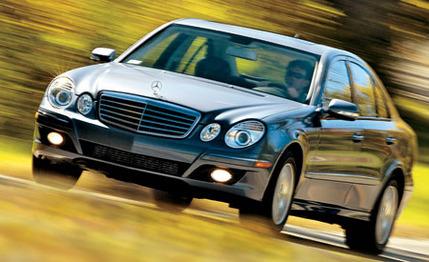 Road Test
Road Test
Here's a number for you: With 400 pound-feet on tap, the Mercedes-Benz E320 BlueTec diesel has 17 more pound-feet of torque than a BMW M5. That's something of a wild-ass comparison, though, because the diesel E320 produces only 208 horsepower—292 fewer than the BMW and 60 fewer than a gasoline E350. The more relevant numbers for a diesel are its fuel mileage, where the E320 BlueTec is rated higher than its gas counterpart by 7 mpg in the city and 11 mpg on the highway, according to the EPA.
Even though the fuel savings are significant, it's hard to ignore the E320's torque, especially since it peaks at 1600 rpm. The source of this power is an all-new DOHC 3.0-liter aluminum V-6 that's fed by an intercooled Garrett turbocharger nestled between the cylinder banks that produces a maximum boost of 29 psi. The seven-speed automatic in the E320 BlueTec is the same as the one found in all other two-wheel-drive E-class models, but the diesel gets the low 2.65:1 final-drive ratio found on the E550 and E63 AMG.
Before we go any further, we should mention that the 2007 E320 BlueTec is on sale in only 45 states. Residents of California, Maine, Massachusetts, New York, and Vermont will have to wait until next year, when the BlueTec receives a 50-state-compliant upgrade to its emissions system. Furthermore, new passenger diesels from any manufacturer must run on ultra-low-sulfur diesel (ULSD), which has at most 15 parts per million of sulfur content and is identified by a sticker at the pump. Unfortunately, EPA regulations only require refiners to produce ULSD as 80 percent of their total diesel output; in December 2010, retailers will be required to sell only ULSD. California has already made the switch. In the rest of the country, finding the right kind of diesel can be a guessing game.
To see how well the E320—which costs $1000 more than a comparable E350—matches up against its gasoline counterpart, we drove one and an E350 Sport from New York City to our offices in Ann Arbor. Apart from the engine, the only differences on the diesel car are smaller front brakes, 16-inch wheels, and a softer suspension; 17-inch wheels are standard on the E350, and Sport models ride on 18s.
The E320 BlueTec is perfectly at home on the highway. It wafts over bumps, and gentle pressure on the pedal easily adds 10 mph to the cruising speed. The E350, in contrast, is livelier and feels lighter than the 136-pound difference between the two cars suggests. But even though throttle response on the E350 is sharp, it takes more pedal pressure for passing acceleration. The E320 lacks the soundtrack of the gas V-6 but makes up for it with torque you can feel every time you hit the throttle. In short, the diesel feels faster.